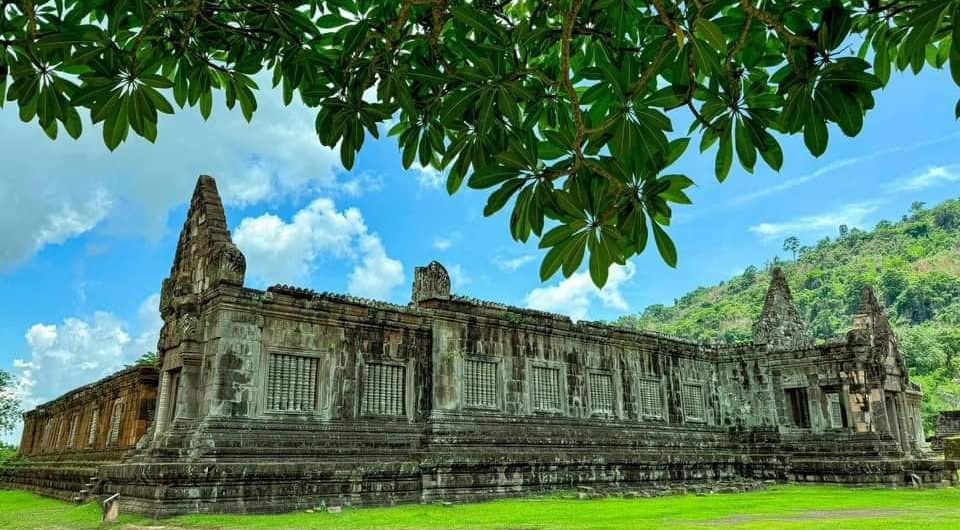Discover Wat Phou Laos, a UNESCO World Heritage temple in Champasak. Explore ancient Khmer ruins, sacred springs, and panoramic Mekong Valley views.
Located away in the tranquil landscapes of southern Laos lies Wat Phou, a UNESCO World Heritage Site where ancient stone stairways lead not only to temple ruins but also to the spiritual heart of the Mekong Valley. For centuries, this sacred complex has drawn pilgrims, monks, kings, and curious travelers who come to marvel at its intricate carvings, feel the presence of ancient deities, and soak in panoramic views over the lush plains below. Whether you’re a history enthusiast, a spiritual seeker, or simply a wanderer with a love for extraordinary places, Wat Phu promises a journey through time — and into the soul of Laos.
Location – Where the Mountains Meet the Mekong
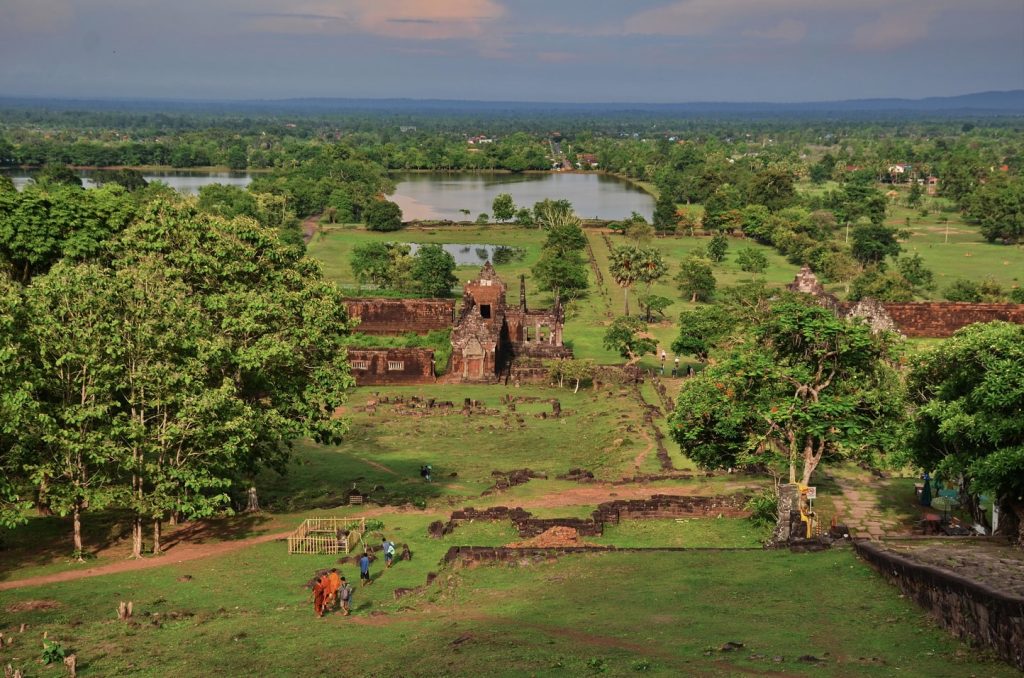
Wat Phu is located in Champasak Province, about 45 kilometers south of Pakse, the regional hub of southern Laos. Its setting is nothing short of poetic: the temple rests at the base of Mount Phou Khao, whose naturally shaped peak resembles a giant lingam — a sacred symbol of Shiva in Hinduism. This mountain has long been revered, and the temple’s alignment directly with its summit reflects ancient Khmer beliefs about the cosmic order.
Just a few kilometers away, the Mekong River flows steadily, its wide waters shimmering under the tropical sun. This proximity to the river was no accident — it ensured access to trade routes, fertile lands, and a constant supply of fresh water from the mountain’s sacred spring.
For modern travelers, the location offers the best of both worlds: a serene countryside escape surrounded by rice paddies and rural villages, yet within easy reach of Champasak town’s guesthouses, restaurants, and riverside cafes.
A Glimpse Into History – From Khmer Glory to Buddhist Serenity
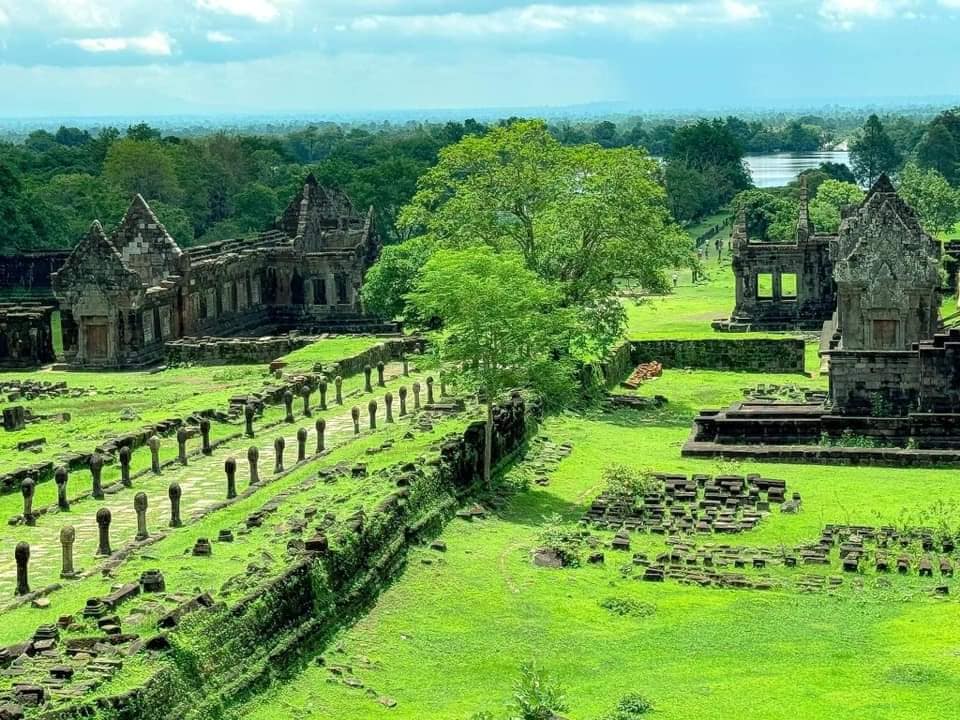
The story of Wat Phu stretches back over 1,500 years. Archaeological evidence suggests that a temple existed here as early as the 5th century, built by the pre-Khmer kingdoms that controlled the Mekong region. However, most of the surviving architecture dates from the 11th to 13th centuries, during the height of the Khmer Empire.
Originally dedicated to Shiva, the Hindu god of destruction and creation, the temple was part of a vast network of religious monuments stretching all the way to Angkor in Cambodia. Its layout — a long causeway leading to terraced sanctuaries and culminating at the mountain’s sacred spring — reflected Hindu cosmology, symbolizing the journey from the earthly realm to the spiritual peak.
As the centuries passed, Theravada Buddhism spread through Laos. Like many temples in the region, Wat Phu was adapted for Buddhist worship, and today, small Buddha statues sit peacefully among the weathered carvings of Hindu gods. This blend of traditions creates an atmosphere that feels both historically rich and spiritually alive.
The Sacred Layout – Walking Through Symbolism
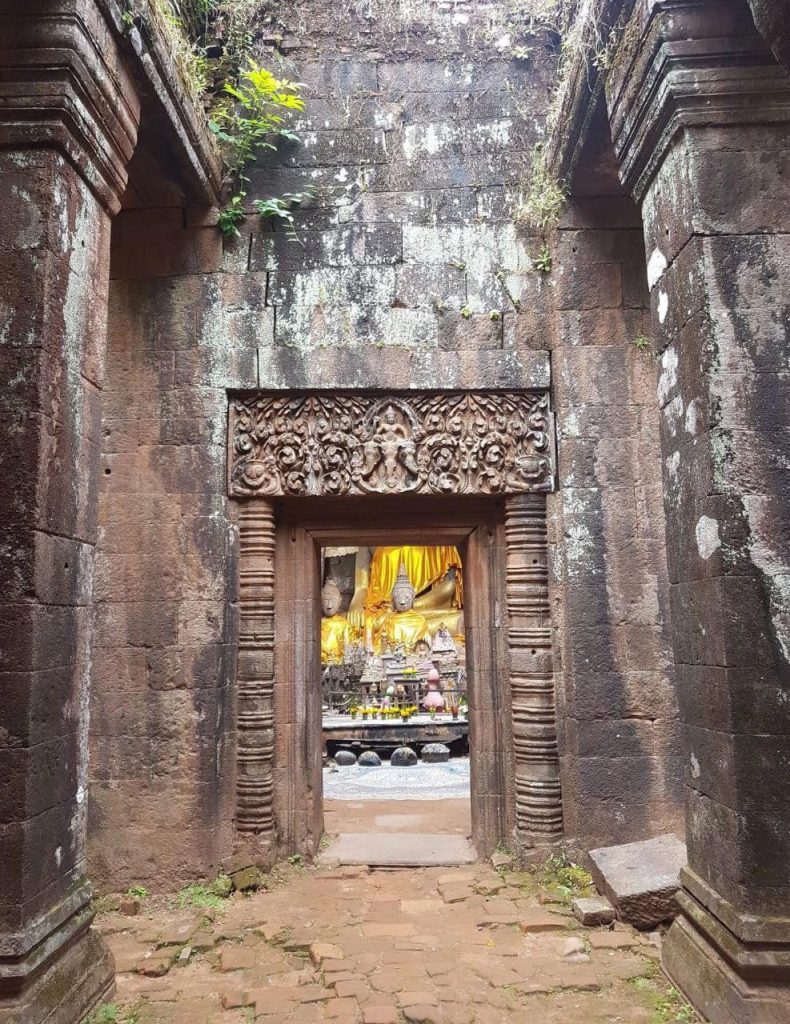
Visiting Wat Phu is as much about the journey as the destination. The temple is laid out in a series of terraces that guide you upward toward the sanctuary at the mountain’s base.
- The Causeway
Your visit begins on a long, straight path flanked by rows of sandstone pillars. Walking here feels like stepping into another time, as you follow the same route taken by kings and pilgrims centuries ago. - The Lower Palaces
Two large rectangular structures, known as the north and south palaces, frame the base of the hill. Though their exact purpose remains debated, they may have served as ceremonial halls or resting places for pilgrims. The weathered sandstone walls still carry traces of elaborate carvings. - The Stone Staircases
From the palaces, a steep stone staircase winds upward. The steps are uneven and worn, shaded by frangipani trees whose blossoms perfume the air. This climb is both a physical and spiritual ascent. - The Upper Sanctuary
At the top, the remains of the main sanctuary stand beside a natural spring. Water flows through the sanctuary and out over a carved stone channel — a feature that has been revered for centuries for its purity and connection to the mountain’s spirit.
When to Visit – Timing Your Journey
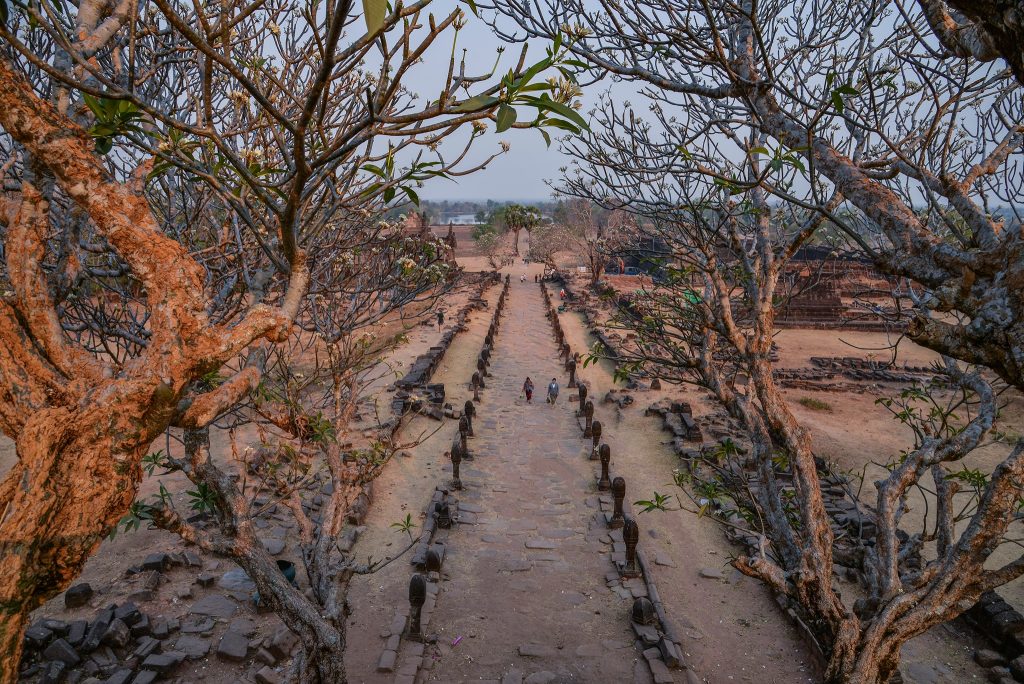
Cool and Dry Season (November to February)
This is the most pleasant time to visit, with cooler temperatures, clear skies, and minimal rainfall. It’s also when the surrounding countryside is green and vibrant after the rainy season.
Boun Wat Phu Festival (February)
If you can, time your visit for the annual Boun Wat Phu Festival. This three-day celebration transforms the site into a living cultural stage, with almsgiving ceremonies, traditional music and dance, boat races, and markets selling local food and crafts. It’s a rare chance to see the temple alive with both religious devotion and communal joy.
Hot Season (March to May)
Temperatures can climb sharply, but this period offers fewer crowds. Bring plenty of water and a hat if visiting midday.
Rainy Season (June to October)
Heavy rains make the landscape lush and photogenic, but also bring slippery paths and occasional flooding. If you don’t mind the showers, you’ll enjoy dramatic skies and fewer tourists.
Getting to Wat Phu – Your Travel Options
From Pakse – Most visitors base themselves in Pakse, which has an airport with connections to Vientiane, Luang Prabang, and Bangkok. From here, Wat Phu is about an hour’s drive. You can hire a private car, take a tuk-tuk, or rent a motorbike.
From Champasak Town – If you prefer to stay closer, Champasak town is just 6 kilometers away. Bicycles, tuk-tuks, or even a leisurely walk are all possible. Boats from the eastern bank of the Mekong can also drop you near the town.
By Tour – Several operators in Pakse and Champasak offer guided tours, often combining Wat Phu with visits to Don Daeng Island or the 4,000 Islands region.
Things to Do at Wat Phou
If you’re planning to include Wat Phou in your next tailor-made Laos tour, take a moment to explore the top things to do there.
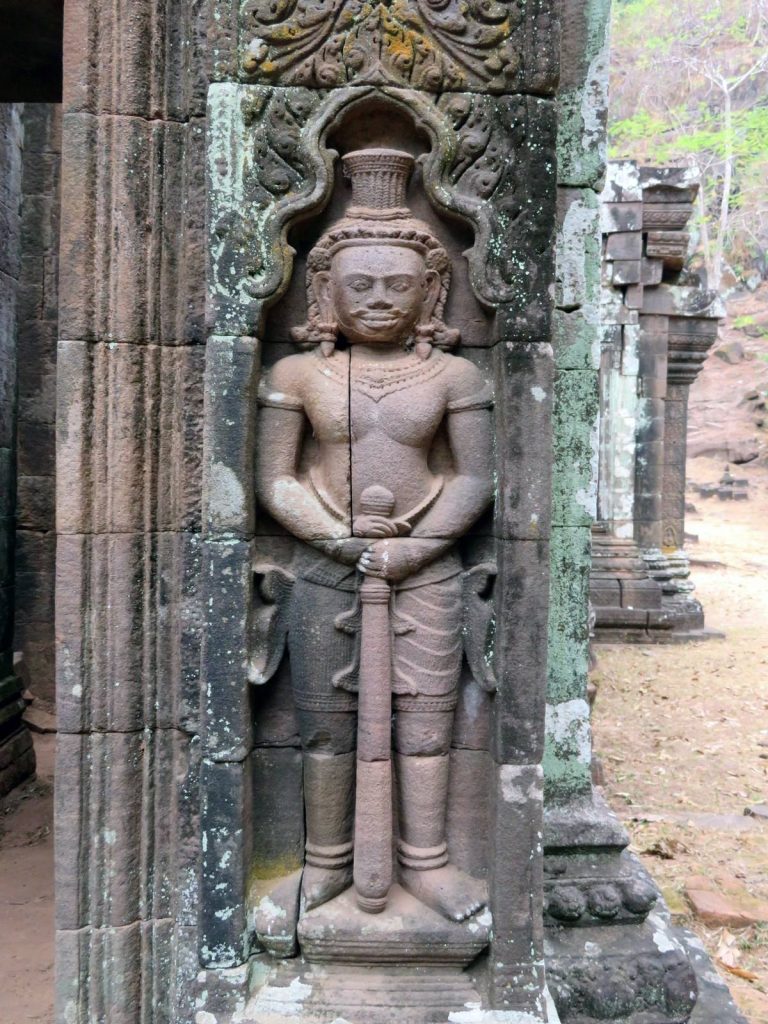
1. Explore the Ruins in Detail
Take time to study the intricate lintels depicting scenes from Hindu mythology — battles of gods and demons, celestial dancers, and sacred animals. A guide can help bring these stories to life.
2. Visit the Sacred Spring
At the upper sanctuary, cool water trickles from the mountain through ancient stonework. Locals still collect and drink it, believing in its healing powers.
3. Enjoy the Panoramic Views
From the upper terrace, you’ll see the Mekong River, the plains dotted with villages, and distant mountains. The view is especially magical in the late afternoon light.
4. Wat Phu Museum
Located near the entrance, the small museum displays statues, inscriptions, and artifacts found at the site, helping you piece together its long history.
5. Experience the Spiritual Atmosphere
Even if you’re not religious, the tranquility here is palpable. Sit in the shade of a frangipani tree, listen to the breeze, and watch saffron-robed monks go about their quiet routines.
Cultural Etiquette – Visiting Respectfully
Wat Phu is still an active place of worship, so respectful behavior is essential:
- Dress modestly – shoulders and knees covered.
- Remove hats when entering sacred spaces.
- Avoid loud voices and be mindful of monks and worshippers.
- Photography is welcome in most areas, but ask before photographing people.
Traveler’s Tips
- Best Time of Day: Early morning for cooler temperatures and softer light for photography.
- Footwear: Wear sturdy shoes for the climb; some stones can be slippery.
- Stay Hydrated: Bring a refillable water bottle.
- Allow Time: Two to three hours is ideal for a leisurely visit.
- Combine Your Trip: Pair Wat Phu with a visit to nearby Don Daeng Island for a peaceful rural experience.
Why Wat Phu Should Be on Your Laos Itinerary
While Laos is famed for Luang Prabang’s gilded temples and Vang Vieng’s karst landscapes, Wat Phu offers something different: a window into the country’s deep history, a connection to the Khmer Empire, and a serene, unspoiled setting far from the usual tourist trail. It’s a place where ancient stones whisper stories of kings and deities, where the natural and spiritual worlds intertwine, and where travelers can slow down, breathe deeply, and feel the weight of centuries beneath their feet.
As you descend from the upper sanctuary, past the frangipani trees and weathered stairways, it’s hard not to feel a sense of quiet awe. Wat Phu is more than a collection of ruins — it’s a living testament to the spiritual heritage of Laos, a place where history, mythology, and nature merge in perfect harmony.
Whether you arrive under the bright morning sun, amid the festive energy of Boun Wat Phu, or in the misty calm of the rainy season, this temple by the mountain will leave an imprint long after you’ve left its stone terraces behind.

